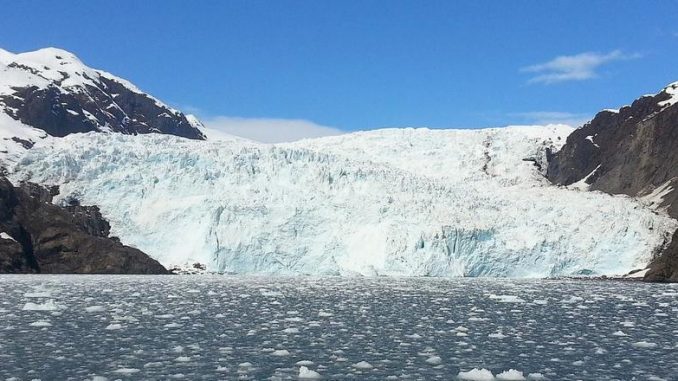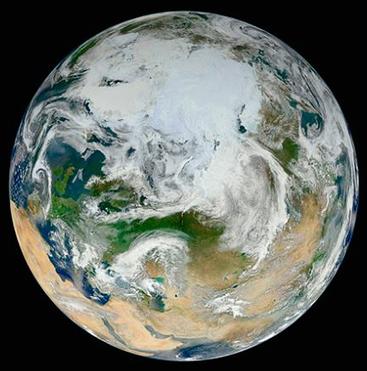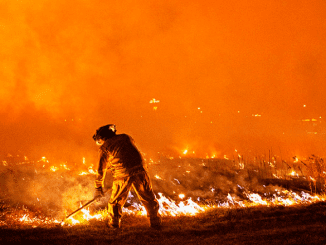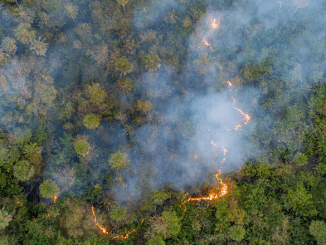
WASHINGTON, DC, May 16, 2021 (ENS) – Glacial melting due to climate change is likely the cause of a shift in the movement of the poles that occurred in the 1990s, new research from China shows.
Melting glaciers redistributed enough water to cause “the direction of polar wander” to turn and accelerate eastward during the mid-1990s, according to a new study in the peer-reviewed scientific journal “Geophysical Research Letters,” the American Geophysical Union’s publication for high-impact reports with immediate implications spanning all Earth and space sciences.
Based in Washington, DC, the American Geophysical Union is an international nonprofit organization of Earth, atmospheric, ocean, hydrologic, space, and planetary scientists, consisting of over 62,000 members from 144 countries
Contrary to popular belief, the locations of the Earth’s North and South poles are not static, unchanging places. “The axis Earth spins around – or more specifically the surface that invisible line emerges from – is always moving due to processes scientists don’t completely understand,” according to the authors of the new study. The way water is distributed on Earth’s surface is one factor that drives the drift.
“The faster ice melting under global warming was the most likely cause of the directional change of the polar drift in the 1990s,” said first author of the new study Shanshan Deng, a doctoral student at the Institute of Geographic Sciences and Natural Resources Research, IGSNRR, at the Chinese Academy of Sciences.

The faster ice melting couldn’t entirely explain the shift, Deng said. She speculated that the slight gap might be due to activities involving land water storage in non-polar regions, such as unsustainable groundwater pumping for agriculture.
Other research has determined more recent movements of the North Pole away from Canada and toward Russia to be caused by factors like molten iron in the Earth’s outer core.
Other axial shifts have been caused in part by what’s called the “terrestrial water storage change,” the process by which all the water on land, even frozen water in glaciers and groundwater stored under continents, is being lost through melting and groundwater pumping.
Scientists have been able to determine the causes of polar drifts starting from 2002 based on data from the Gravity Recovery and Climate Experiment, or GRACE, a joint mission by the U.S. National Aeronautics and Space Administration, NASA, and the German Aerospace Center, launched with twin satellites in 2002 and a follow up mission in 2018.
The GRACE mission gathered information on how mass is distributed around the planet by measuring uneven changes in gravity at different points.
The Earth spins around an axis kind of like a top, explains Dr. Vincent Humphrey, a climate scientist at the University of Zurich who was not involved in the Chinese research study. If the weight of a top is moved around, he says, the spinning top would start to lean and wobble as its rotational axis changes. The same thing happens to the Earth as weight is shifted from one area to the other.
Humphrey said that the Chinese research, “tells you how strong this mass change is. It’s so big that it can change the axis of the Earth.”
The change to the Earth’s axis isn’t large enough to affect daily life, he said. It could change the length of day we experience, but only by milliseconds.
The evidence from the IGSNRR study reveals how much direct human activity can have an impact on changes to the mass of water on land, Humphrey said. “Their analysis revealed large changes in water mass in areas like California, northern Texas, the region around Beijing and northern India, for example, all areas that have been pumping large amounts of groundwater for agricultural use.”

“The ground water contribution is also an important one,” Humphrey said. “Here you have a local water management problem that is picked up by this type of analysis.”
The study’s authors demonstrated that this water loss on land contributed to the shifts in the polar drift in the past 25 years by changing the way mass is distributed around the world. They wanted to see if it could also explain changes that occurred in the mid-1990s.
In 1995, the direction of polar drift shifted from southward to eastward. The average speed of drift from 1995 to 2020 increased about 17 times from the average speed recorded from 1981 to 1995.
Researchers now have found a way to wind modern pole tracking analysis backward in time to learn why this drift occurred. The new research calculates the total land water loss in the 1990s before the GRACE mission started.
“The findings offer a clue for studying past climate-driven polar motion,” said Suxia Liu, a hydrologist at the IGSNRR and the corresponding author of the new study. “The goal of this project, funded by the Ministry of Science and Technology of China is to explore the relationship between the water and polar motion.”
Using data on glacier loss and estimations of ground water pumping, Liu and her colleagues calculated how the water stored on land changed. They found that the contributions of water loss from the polar regions is the main driver of polar drift, with contributions from water loss in nonpolar regions. Together, all this water loss explained the eastward change in polar drift.
Liu said the research has larger implications for our understanding of land water storage earlier in the 20th century. Researchers have 176 years of data on polar drift. By using some of the methods highlighted by Liu and her colleagues, it could be possible to use those changes in direction and speed to estimate how much land water was lost in past years.
Featured image: A glacier near Seward, Alaska melts into Resurrection Bay. 2007 (Photo courtesy NASA)



